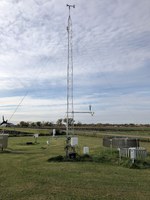NDAWN Awarded $6.4 Million Grant
(Click the image below to view a high-resolution image that can be downloaded)
The U.S. Army Corps of Engineers has awarded the North Dakota Agricultural Weather Network (NDAWN) a $6.4 million five-year contract to retrofit existing stations and build new stations across North Dakota.
NDAWN, which is part of North Dakota State University’s North Dakota Agricultural Experiment Station, consists of 159 stations distributed across North Dakota and border regions of surrounding states. They monitor and record local weather conditions throughout the state and the Red River Valley, and disseminate timely, detailed, accurate information through an array of applications, summaries and innovative displays that are free to everyone on the NDAWN website (https://ndawn.ndsu.nodak.edu).
The contract is part of a larger, five-state project focused on weather monitoring in the Upper Missouri River Basin that will improve the data available for water management by the Corps of Engineers.
“The one climate element that we have the least amount of data on is the moisture content in snow,” says Daryl Ritchison, NDAWN director. “Every storm, you will hear about the total depth from numerous sites, but it’s not the depth but the amount of water in the snow that is the most important in spring flood forecasts.”
One of the many variables that this project will record will be the moisture content in every snow storm in areas where such data is unavailable.
“The goal is to monitor the total water inputs in the Upper Missouri River Basin, meaning not only the precipitation that falls from the sky, but also monitoring the amount of moisture present in the soil,” Ritchison says. “These variables impact not only flooding, but also drought.”
NDAWN was designed to provide weather data for the development of agricultural models. Producers can make management decisions using models that predict future crop and pest development based on recent weather conditions. These models can warn of impending disease or insect infestations so producers can apply pesticides at the optimum time for maximum efficacy to improve crop yields and profits.
NDAWN data also has many other uses, including for weather forecasting/research, government policy decisions, natural resource management, landfill operation, utility planning and operation, claims adjusting, resolution of legal questions, environmental research, hydrologic forecasting and management, water quality management, structure site selection and determining wind or solar power potential. The news media, educators, students, weather hobbyists and others find NDAWN data indispensable as well.
NDSU Agriculture Communication - Oct. 5, 2020
Source: Daryl Ritchison, 701-231-8209, daryl.ritchison@ndsu.edu
Editor: Ellen Crawford, 701-231-5391, ellen.crawford@ndsu.edu


